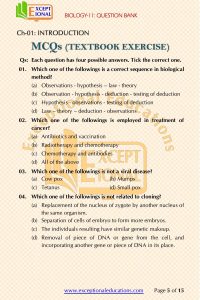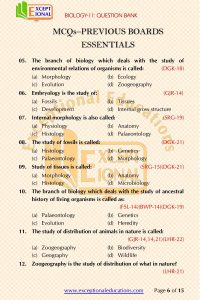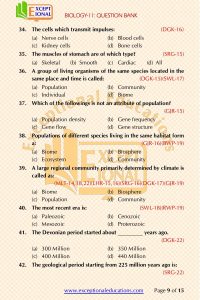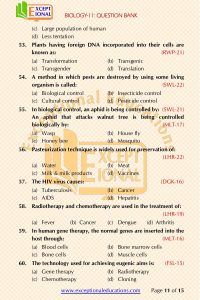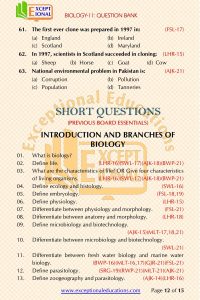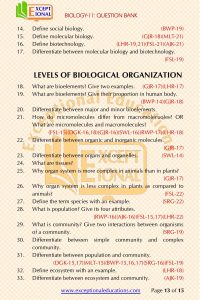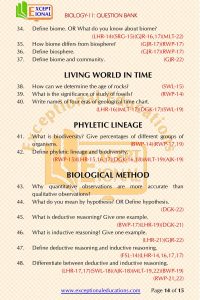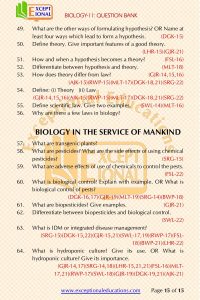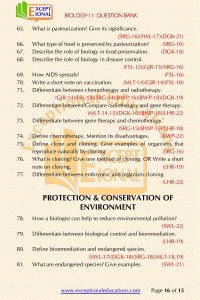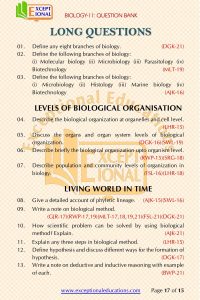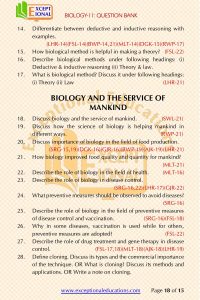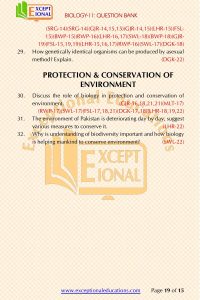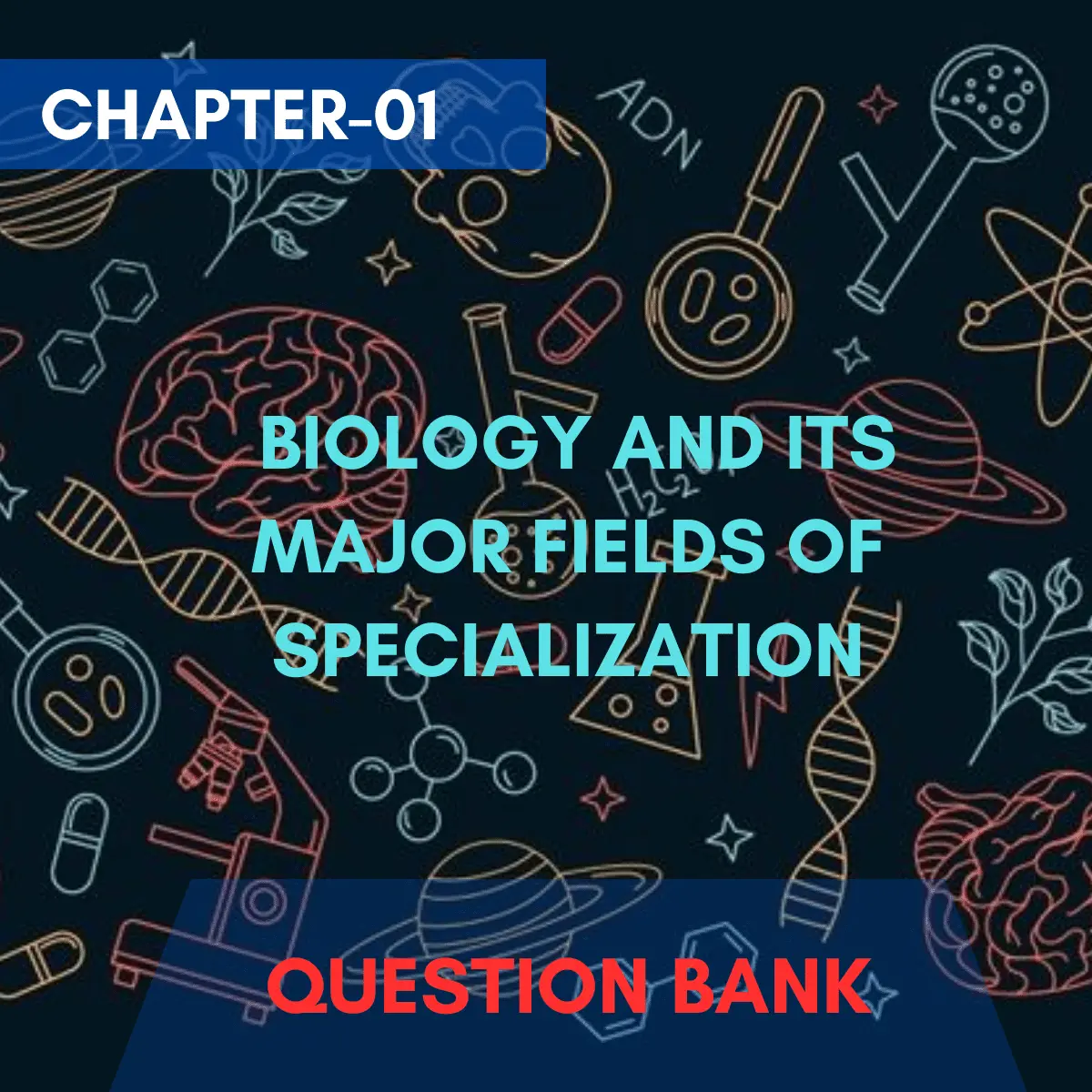Here is a vast range of objective and subjective questions in this question bank of biology 11, chapter 01. Following types of questions have been included here.
- MCQs (Textbook Exercise)
- MCQs (Previous Boards Essentials)
- SQs Topic-wise (Previous Boards Essentials + Textbook Conceptuals)
- LQs (Previous Boards Essentials)
You can find solutions to these questions from our publication, “An Insight Into Objective Biology-11”.
MCQs (Textbook Exercise)
Each question has four possible answers. Tick the correct one.
1: Which one of the followings is a correct sequence in biological method?
(a) Observations – hypothesis – law – theory
(b) Observation – hypothesis – deduction – testing of deduction
(c) Hypothesis – observations – testing of deduction
(d) Law – theory – deduction – observations
2: Which one of the followings is employed in treatment of cancer?
(a) Antibiotics and vaccination
(b) Radiotherapy and chemotherapy
(c) Chemotherapy and antibodies
(d) All of the above
3: Which one of the followings is not a viral disease?
(a) Cow pox
(b) Mumps
(c) Tetanus
(d) Small pox
4: Which one of the followings is not related to cloning?
(a) Replacement of the nucleus of zygote by another nucleus of the same organism.
(b) Separation of cells of embryo to form more embryos.
(c) The individuals resulting have similar genetic makeup.
(d) Removal of piece of DNA or gene from the cell, and incorporating another gene or piece of DNA in its place.
MCQs (Previous Boards Essentials)
(1) The branch of biology which deals with the study of environmental relations of organisms is called: (DGK-18)
(a) Morphology
(b) Ecology
(c) Evolution
(d)Zoogeography
(2) Embryology is the study of: (GJR-14)
(a) Fossils
(b) Tissues
(c) Development
(d) Internal gross structure
(3) Internal morphology is also called: (SRG-19)
(a) Physiology
(b) Anatomy
(c) Histology
(d) Palaeontology
(4) The study of fossils is called: (DGK-21)
(a) Histology
(b) Genetics
(c) Palaeontology
(d) Morphology
(5) Study of tissues is called: (SRG-15)(DGK-21)
(a) Morphology
(b) Anatomy
(c) Histology
(d) Microbiology
(6) The branch of biology which deals with the study of ancestral history of living organisms is called as: (FSL-14)(BWP-14)(DGK-19)
(a) Palaeontology
(b) Genetics
(c) Evolution
(d) Heredity
(7) The study of distribution of animals in nature is called: (GJR-14,14,21)(LHR-22)
(a) Zoogeography
(b) Biodiversity
(c) Geography
(d) Wildlife
(8) Zoogeography is the study of distribution of what in nature? (LHR-21)
(a) Animals
(b) Plants
(c) Trees
(d) Zoos
(9) The branch of biology which deals with the study of chemical components and chemical processes in living organism is called: (FSL-21)
(a) Biochemistry
(b) Biogenetics
(c) Biotechnology
(d) Biology
(10) The study of microorganisms including bacteria, virus, protozoa and microscopic algae and fungi is: (AJK-15)
(a) Microbiology
(b) Parasitology
(c) Molecular biology
(d) Biotechnology
(11) The study of parasites is called: (LHR-16)
(a) Palaeontology
(b) Histology
(c) Microbiology
(d) Parasitology
(12) Study of social behaviour of human is called: (GJR-18)
(a) Anatomy
(b) Social biology
(c) Palaeontology
(d) Physiology
(13) The branch of biology which deals with the use of living organisms, systems or processes in manufacturing and service industries is called: (GJR-21)
(a) Biotechnolog
(b) Human biology
(c) Molecular biology
(d) Social biology
(14) The 16 elements that occur in organisms are called: (GJR-22)
(a) Essential element
(b) Bioelements
(c) Common elements
(d) Important elements
(15) The bioelements which account for 99% of the total mass in the human body are: (LHR-18)
(a) Four
(b) Six
(c) Eight
(d) Three
(16) In human body, the amount of oxygen is: (LHR-17)
(a) 50
(b) 65%
(c) 70%
(d) 40%
(17) The percentage of carbon in human body: (DGK-17)(AJK-19)
(a) 65
(b) 10%
(c) 18%
(d) 3%
(18) The bioelement which accounts for 18% of total mass in human body is: (GJR-17)
(a) Oxygen
(b) Carbon
(c) Hydrogen
(d) Nitrogen
(19) The percentage of hydrogen in human body is: (RWP-17)
(a) 20
(b) 15%
(c) 10%
(d) 5%
(20) In human body, the percentage of nitrogen accounts for: (SWL-19)
(a) 2%
(b) 3%
(c) 1%
(d) 10%
(21) The percentage of calcium in human body is: (FSL-18)
(a) 1%
(b) 2%
(c) 3%
(d) 4%
(22) The percentage of potassium in human body is: (RWP-16)
(a) 0.15%
(b) 0.05%
(c) 0.35%
(d) 0.25%
(23) In human body, the amount of iron is: (FSL-22)
(a) 4%
(b) 0.4%
(c) 0.04%
(d) 0.004%
(24) The lowest percentage of bioelements in man among the followings is of: (MLT-15)
(a) Chlorine
(b) Sulphur
(c) Manganese
(d) Iron
(25) One of the followings is a micromolecule? (SRG-16)
(a) Starch
(b) Protein
(c) Cellulose
(d) Glucose
(26) Which one of these is a macromolecule? (BWP-18)
(a) H2O
(b) CO2
(c) O2
(d) Starch
(27) Which one of these is a macromolecule? (AJK-22)
(a) H2O
(b) CO2
(c) O2
(d) DNA
(28) The unit of life is called: (BWP-16,17)
(a) Atom
(b) Cell
(c) Tissue
(d) Organ
(29) A group of similar cells that perform similar functions is called: (RWP-15)(LHR-17,18)(DGK-18)
(a) Organ
(b) Organelles
(c) Tissue
(d) System
(30) The cells which transmit impulses: (DGK-16)
(a) Nerve cells
(b) Blood cells
(c) Kidney cells
(d) Bone cells
(31) The muscles of stomach are of which type? (SRG-15)
(a) Skeletal
(b) Smooth
(c) Cardiac
(d) All
(32) A group of living organisms of the same species located in the same place and time is called: (DGK-15)(SWL-17)
(a) Population
(b) Community
(c) Individual
(d) Biome
(33) Which of the followings is not an attribute of population? (GJR-15)
(a) Population density
(b) Gene frequency
(c) Gene flow
(d) Gene structure
(34) Populations of different species living in the same habitat form a: (GJR-16)(BWP-19)
(a) Biome
(b) Biosphere
(c) Ecosystem
(d) Community
(35) A large regional community primarily determined by climate is called as: (MLT-14,18,22)(LHR-15,16)(SRG-16)(DGK-17)(GJR-19)
(a) Biome
(b) Biosphere
(c) Population
(d) Community
(36) The most recent era is: (SWL-18)(RWP-19)
(a) Paleozoic
(b) Cenozoic
(c) Mesozoic
(d) Proterozoic
(37) The Devonian period started about ________ years ago. (DGK-22)
(a) 300 Million
(b) 350 Million
(c) 400 Million
(d) 440 Million
(38) The geological period starting from 225 million years ago is: (SRG-22)
(a) Jurassic
(b) Permian
(c) Triassic
(d) Silurian
(39) Mammals become dominant in: (GJR-22)(RWP-22)
(a) Paleozoic era
(b) Proterozoic era
(c) Mesozoic era
(d) Cenozoic era
(40) The number and variety of species in a place is called: (FSL-19)
(a) Population
(b) Community
(c) Diversity
(d) Biodiversity
(41) The number of species of insects is: (SRG-18)
(a) 22.5%
(b) 17.6%
(c) 15.5%
(d) 53.1%
(42) The number of plant species in biodiversity is: (FSL-19)
(a) 53.1%
(b) 17.6 %
(c) 19.9%
(d) 9.4 %
(43) The tentative explanation of observation: (BWP-15)(SWL-16)(AJK-16)(DGK-16)(MLT-17,21)
(a) Hypothesis
(b) Deduction
(c) Law
(d) Theory
(44) The reasoning that moves from general to specific is: (DGK-15)(MLT-19)(LHR-21)
(a) Deductive
(b) Inductive
(c) Scientific
(d) Theoretical
(45) In deductive reasoning, we move from: (MLT-19)(FSL-21)
(a) General to specific
(b) Specific to general
(c) General to general
(d) Specific to specific
(46) In inductive reasoning, we move from: (BWP-21)
(a) General to specific
(b) Specific to general
(c) General to general
(d) Specific to specific
(47) It is virtually an irrefutable theory: (MLT-21)
(a) Hypothesis
(b) Deduction
(c) Scientific law
(d) Experiment
(48) Biology is short in laws because of: (GJR-16)
(a) Elusive nature of life
(b) Less falsification
(c) Large population of human
(d) Less tentation
(49) Plants having foreign DNA incorporated into their cells are known as: (RWP-21)
(a) Transformation
(b) Transgenic
(c) Transgender
(d) Translation
(50) A method in which pests are destroyed by using some living organism is called: (SWL-22)
(a) Biological control
(b) Insecticide control
(c) Cultural control
(d) Pesticide control
(51) An aphid that attacks walnut tree is being controlled biologically by: (MLT-17)(SWL-21)
(a) Wasp
(b) House fly
(c) Honey bee
(d) Mosquito
(52) Pasteurization technique is widely used for preservation of: (LHR-22)
(a) Water
(b) Meat
(c) Milk & milk products
(d) Vaccines
(53) The HIV virus causes: (DGK-16)
(a) Tuberculosis
(b) Cancer
(c) AIDS
(d) Hepatitis
(54) Radiotherapy and chemotherapy are used in the treatment of: (LHR-19)
(a) Fever
(b) Cancer
(c) Dengue
(d) Arthritis
(55) In human gene therapy, the normal genes are inserted into the host through: (MLT-16)
(a) Blood cells
(b) Bone marrow cells
(c) Bone cells
(d) Muscle cells
(56) The technology used for achieving eugenic aims is: (FSL-15)
(a) Gene therapy
(b) Radiotherapy
(c) Chemotherapy
(d) Cloning
(57) The first ever clone was prepared in 1997 in: (FSL-17)
(a) England
(b) Ireland
(c) Scotland
(d) Maryland
(58) In 1997, scientists in Scotland succeeded in cloning: (LHR-15)
(a) Sheep
(b) Horse
(c) Goat
(d) Cow
(59) National environmental problem in Pakistan is: (AJK-21)
(a) Corruption
(b) Pollution
(c) Population
(d) Tanneries
Short Questions
INTRODUCTION AND BRANCHES OF BIOLOGY
Q.01: What is biology?
Q.02: Define life. (LHR-16)(SWL-17)(AJK-18)(BWP-21)
Q.03: What are the characteristics of life? OR Give four characteristics of living organisms. (LHR-16)(SWL-17)(AJK-18)(BWP-21)
Q.04: Define ecology and histology. (SWL-16)
Q.05: Define embryology. (FSL-18,19)
Q.06: Define physiology. (LHR-15)
Q.07: Differentiate between physiology and morphology. (FSL-21)
Q.08: Differentiate between anatomy and morphology. (LHR-18)
Q.09: Define microbiology and biotechnology. (AJK-15)(MLT-17,18,21)
Q.10: Differentiate between microbiology and biotechnology. (SWL-21)
Q.11: Differentiate between fresh water biology and marine water biology. (BWP-16)(MLT-16,17)(GJR-21)(FSL-21)
Q.12: Define parasitology. (SRG-19)(RWP-21)(MLT-21)(AJK-21)
Q.13: Define zoogeography and parasitology. (AJK-14)(LHR-16)
Q.14: Define social biology. (BWP-19)
Q.15: Define molecular biology. (GJR-18)(MLT-21)
Q.16: Define biotechnology. (LHR-19,21)(FSL-21)(AJK-21)
Q.17: Differentiate between molecular biology and biotechnology. (FSL-19)
LEVELS OF BIOLOGICAL ORGANIZATION
Q.18: What are bioelements? Give two examples. (GJR-17)(LHR-17)
Q.19: What are bioelements? Give their proportion in human body. (BWP-14)(GJR-18)
Q.20: Differentiate between major and minor bioelements.
Q.21: How do micromolecules differ from macromolecuoles? OR What are micromolecules and macromolecules? (FSL-15)(DGK-16,18)(GJR-16)(SWL-16)(RWP-17)(LHR-18)
Q.22: Differentiate between organic and inorganic molecules. (GJR-17)
Q.23: Differentiate between organs and organelles. (SWL-14)
Q.24: What are tissues?
Q.25: Why organ system is more complex in animals than in plants? (GJR-17)
Q.26: Why organ system is less complex in plants as compared to animals? (FSL-22)
Q.27: Define the term species with an example. (SRG-22)
Q.28: What is population? Give its four attributes. (RWP-16)(AJK-16)(FSL-15,17)(LHR-22)
Q.29: What is community? Give two interactions between organisms of a community. (SRG-19)
Q.30: Differentiate between simple community and complex community.
Q.31: Differentiate between population and community. (DGK-15,17)(MLT-15)(BWP-15,16,17)(SRG-16)(FSL-19)
Q.32: Define ecosystem with an example. (LHR-18)
Q.33: Differentiate between ecosystem and community. (AJK-19)
Q.34: Define biome. OR What do you know about biome? (LHR-14)(SRG-15)(GJR-16,17)(MLT-22)
Q.35: How biome differs from biosphere? (GJR-17)(RWP-17)
Q.36: Define biosphere. (GJR-17)(RWP-17)
Q.37: Define biome and community. (GJR-22)
LIVING WORLD IN TIME
Q.38: How can we determine the age of rocks? (SWL-15)
Q.39: What is the significance of study of fossils? (RWP-14)
Q.40: Write names of four eras of geological time chart.
(LHR-16)(MLT-17)(DGK-17)(SWL-19)
PHYLETIC LINEAGE
Q.41: What is biodiversity? Give percentages of different groups of organisms. (BWP-14)(RWP-17,19)
Q.42: Define phyletic lineage and biodiversity. (RWP-15)(LHR-15,16,17)(DGK-16,18)(MLT-19)(AJK-19)
BIOLOGICAL METHOD
Q.43: Why quantitative observations are more accurate than qualitative observations?
Q.44: What do you mean by hypothesis? OR Define hypothesis. (DGK-22)
Q.45: What is deductive reasoning? Give one example. (BWP-17)(LHR-19)(DGK-21)
Q.46: What is inductive reasoning? Give one example. (LHR-21)(GJR-22)
Q.47: Define deductive reasoning and inductive reasoning. (FSL-14)(LHR-14,16,17,17)
Q.48: Differentiate between deductive and inductive reasoning. (LHR-17,17)(SWL-18)(AJK-18)(MLT-19,22)(BWP-19)(RWP-21,22)
Q.49: What are the other ways of formulating hypothesis? OR Name at least four ways which lead to form a hypothesis. (DGK-15)
Q.50: Define theory. Give important features of a good theory. (LHR-15)(GJR-21)
Q.51: How and when a hypothesis becomes a theory? (FSL-16)
Q.52: Differentiate between hypothesis and theory. (MLT-18)
Q.53: How does theory differ from law? (GJR-14,15,16)(AJK-15)(RWP-15)(MLT-17)(DGK-18,21)(SRG-22)
Q.54: Define: (i) Theory (ii) Law (GJR-14,15,16)(AJK-15)(RWP-15)(MLT-17)(DGK-18,21)(SRG-22)
Q.55: Define scientific law. Give two examples. (SWL-14)(MLT-16)
Q.56: Why are there a few laws in biology?
BIOLOGY IN THE SERVICE OF MANKIND
Q.57: What are transgenic plants?
Q.58: What are pesticides? What are the side effects of using chemical pesticides? (SRG-15)
Q.59: What are adverse effects of use of chemicals to control the pests. (FSL-22)
Q.60: What is biological control? Explain with example. OR What is biological control of pests? (DGK-16,17)(GJR-19)(MLT-19)(SRG-14)(BWP-18)
Q.61: What are biopesticides? Give examples. (GJR-21)
Q.62: Differentiate between biopesticides and biological control. (SWL-22)
Q.63: What is IDM or integrated disease management? (SRG-15)(DGK-15,22)(GJR-15,21)(SWL-17,19)(RWP-17)(FSL-18)(BWP-21)(LHR-22)
Q.64: What is hydroponic culture? Give its use. OR What is hydroponic culture? Give its importance. (GJR-14,17)(SRG-14,18)(LHR-15,21,21)(FSL-16)(MLT-17,21)(RWP-17)(SWL-18)(GJR-19)(DGK-19,21)(AJK-21)
Q.65: What is pasteurization? Give its significance. (SRG-16)(SWL-17)(DGK-21)
Q.66: What type of food is preserved by pasteurization? (SRG-16)
Q.67: Describe the role of biology in food preservation. (DGK-16)
Q.68: Describe the role of biology in disease control. (FSL-15)(GJR-15)(SRG-16)
Q.69: How AIDS spreads? (FSL-16)
Q.70: Write a short note on vaccination. (MLT-14)(GJR-14)(FSL-18)
Q.71: Differentiate between chemotherapy and radiotherapy. (GJR-14)(FSL-14)(SRG-14)(RWP-16)(BWP-18)(DGK-19)
Q.72: Differentiate between/Compare radiotherapy and gene therapy. (MLT-14,15)(DGK-16)(BWP-18)(LHR-22)
Q.73: Differentiate between gene therapy and chemotherapy. (SRG-15)(BWP-15)(LHR-18)
Q.74: Define chemotherapy. Mention its disadvantages. (RWP-22)
Q.75: Define clone and cloning. Give examples of organisms that reproduce naturally by cloning. (SRG-16)
Q.76: What is cloning? Give one method of cloning. OR Write a short note on cloning. (LHR-19)
Q.77: Differentiate between embryonic and organism cloning. (LHR-22)
PROTECTION & CONSERVATION OF ENVIRONMENT
Q.78: How a biologist can help to reduce environmental pollution? (SWL-22)
Q.79: Differentiate between biological control and bioremediation. (LHR-19)
Q.80: Define bioremediation and endangered species. (SWL-17)(DGK-18)(SRG-18)(MLT-18,19)
Q.81: What are endangered species? Give examples. (SWL-21)
Long Questions
Q.1: Define any eight branches of biology. (DGK-21)
Q.2: Define the following branches of biology:
(i) Molecular biology (ii) Microbiology (iii) Parasitology (iv) Biotechnology (MLT-19)
Q.3: Define the following branches of biology:
(i) Microbiology (ii) Histology (iii) Marine biology (iv) Biotechnology (AJK-16)
LEVELS OF BIOLOGICAL ORGANISATION
Q.4: Describe the biological organization at organelles and cell level. (LHR-15)
Q.5: Discuss the organs and organ system levels of biological organization. (DGK-16)(SWL-19)
Q.6: Describe briefly the biological organization upto organism level. (RWP-15)(SRG-18)
Q.7: Describe population and community levels of organization in biology. (FSL-16)(LHR-18)
LIVING WORLD IN TIME
Q.8: Give a detailed account of phyletic lineage. (AJK-15)(SWL-16)
Q.9: Write a note on biological method. (GJR-17)(RWP-17,19)(MLT-17,18,19,21)(FSL-21)(DGK-21)
Q.10: How scientific problem can be solved by using biological method? Explain. (AJK-21)
Q.11: Explain any three steps in biological method. (LHR-15)
Q.12: Define hypothesis and discuss different ways for the formation of hypothesis. (DGK-17)
Q.13: Write a note on deductive and inductive reasoning with example of each.(BWP-21)
Q.14: Differentiate between deductive and inductive reasoning with examples. (LHR-14)(FSL-14)(BWP-14,21)(MLT-14)(DGK-15)(RWP-17)
Q.15: How biological method is helpful in making a theory? (FSL-22)
Q.16: Describe biological methods under following headings: (i) Deductive & inductive reasoning (ii) Theory & law.
Q.17: What is biological method? Discuss it under following headings: (i) Theory (ii) Law (LHR-21)
BIOLOGY AND THE SERVICE OF MANKIND
Q.18: Discuss biology and the service of mankind. (SWL-21)
Q.19: Discuss how the science of biology is helping mankind in different ways. (RWP-21)
Q.20: Discuss importance of biology in the field of food production. (SRG-15,19)(DGK-16)(GJR-16)(BWP-19)(AJK-19)(LHR-21)
Q.21: How biology improved food quality and quantity for mankind? (MLT-21)
Q.22: Describe the role of biology in the field of health. (MLT-16)
Q.23: Describe the role of biology in disease control. (SRG-16,22)(LHR-17)(GJR-22)
Q.24: What preventive measures should be observed to avoid diseases? (SRG-16)
Q.25: Describe the role of biology in the field of preventive measures of disease control and vaccination. (SRG-16)(FSL-18)
Q.26: Why in some diseases, vaccination is used while for others, preventive measures are adopted? (FSL-22)
Q.27: Describe the role of drug treatment and gene therapy in disease control. (FSL-17,18)(MLT-18)(AJK-18)(LHR-19)
Q.28: Define cloning. Discuss its types and the commercial importance of the technique. OR What is cloning? Discuss its methods and applications. OR Write a note on cloning. (SRG-14)(SRG-14)(GJR-14,15,15)(GJR-14,15)(LHR-15)(FSL-15)(BWP-15)(RWP-16)(LHR-16,17)(SWL-18)(BWP-18)(GJR-19)(FSL-15,19,19)(LHR-15,16,17)(RWP-16)(SWL-17)(DGK-18)
Q.29: How genetically identical organisms can be produced by asexual method? Explain. (DGK-22)
PROTECTION & CONSERVATION OF ENVIRONMENT
Q.30: Discuss the role of biology in protection and conservation of environment. (GJR-16,18,21,21)(MLT-17)(RWP-17)(SWL-17)(FSL-17,18,21)(DGK-17,18)(LHR-18,19,22)
Q.31: The environment of Pakistan is deteriorating day by day, suggest various measures to conserve it. (LHR-22)
Q.32: Why is understanding of biodiversity important and how biology is helping mankind to conserve environment? (SWL-22)
Give your feedback about the work. If you have some suggestions, pass on to us through comments or email. We will try improve accordingly. Thanks!
